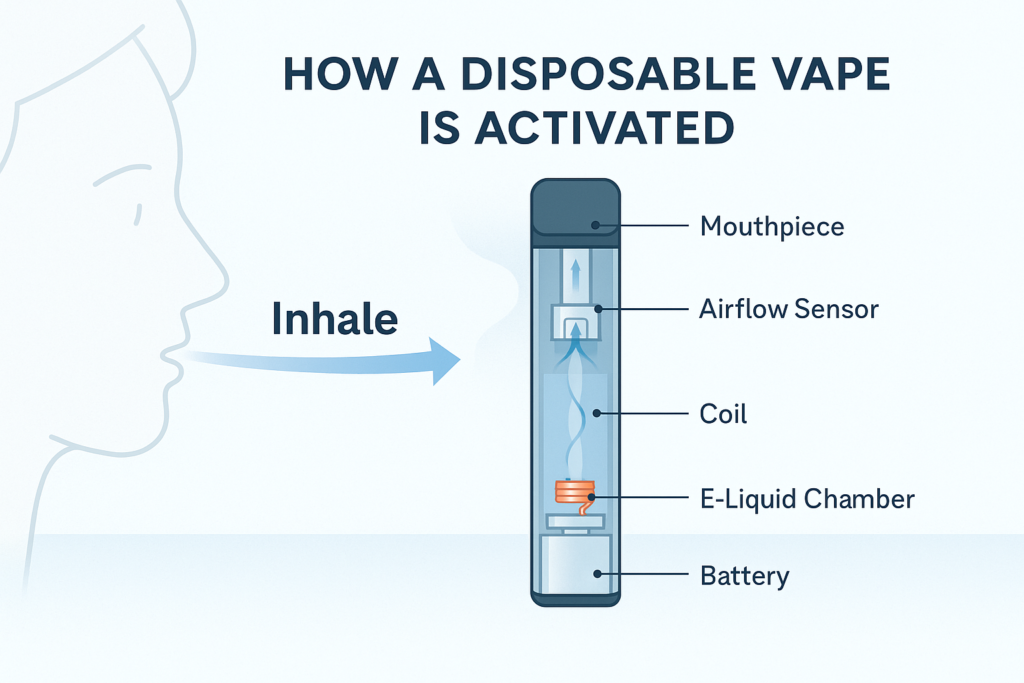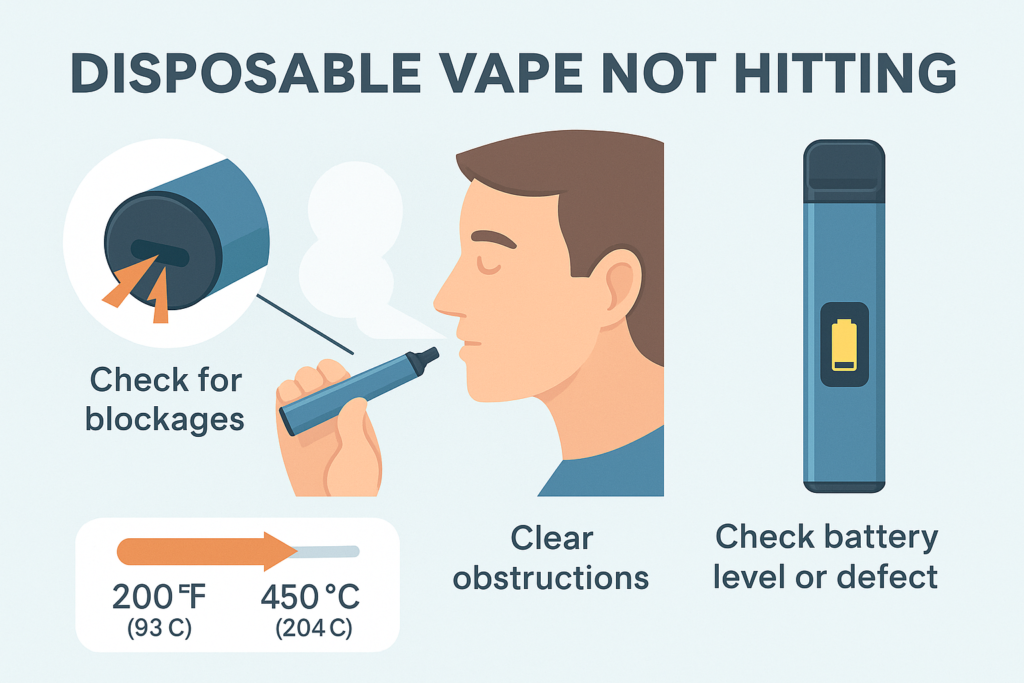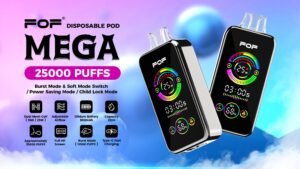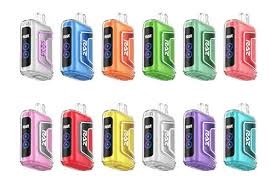Disposable vapes are convenient, but how do they actually work? Let's explore the inner workings of the FOF Mega Disposable Vape.
The FOF Mega Disposable Vape works by heating e-liquid with a coil powered by a battery, creating vapor that you inhale. It's pre-filled, pre-charged, and designed for single-use. Simply inhale to activate the device; buttons for setting the 16w and 25w power and Childproof lock and power off,power on.
 "A detailed illustration of the internal components of a disposable vape, including the battery, coil, and e-liquid reservoir"
"A detailed illustration of the internal components of a disposable vape, including the battery, coil, and e-liquid reservoir"
I've seen many disposable vapes come and go, and understanding their basics is key. Let's break down the mechanics of the FOF Mega.
How do you activate disposable vapes?
Activation is super simple.
Disposable vapes are activated by simply inhaling on the mouthpiece. This draws air across a sensor, which then activates the battery to heat the coil and vaporize the e-liquid. No buttons or switches are needed.
 "An image showing a person using a disposable vape, highlighting the ease of activation through inhalation"
"An image showing a person using a disposable vape, highlighting the ease of activation through inhalation"
It's all about that breath-activated technology.
The components that enable the breath-activated mechanism1 in disposable vapes include the airflow sensor2, the battery, and the heating coil. Drawing from my understanding of electronics and vaping technology, I've identified the following key elements. The airflow sensor detects when a user inhales, triggering the device to activate – the airflow sensor detects when a user inhales, triggering the device to activate and initiate the vaporization process. The battery provides the power needed to heat the coil – the battery provides the power needed to heat the coil, enabling it to vaporize the e-liquid and produce vapor. The heating coil vaporizes the e-liquid when it is heated by the battery – the heating coil vaporizes the e-liquid when it is heated by the battery, converting it into a vapor that can be inhaled. The electronic circuit connects the airflow sensor, battery, and heating coil – the electronic circuit connects the airflow sensor, battery, and heating coil, coordinating their functions to deliver a seamless vaping experience. The microprocessor controls the activation and deactivation of the device – the microprocessor controls the activation and deactivation of the device, ensuring that it only operates when the user is inhaling and preventing accidental activation.
The potential problems that can occur with the breath-activated mechanism include a faulty sensor, a dead battery, or a clogged airflow. Through analyzing user feedback and troubleshooting guides, I've identified the following common issues. The faulty sensor may not detect the airflow, preventing the device from activating – a faulty sensor may not detect the airflow, preventing the device from activating and requiring the user to seek a replacement. The dead battery will not provide power to the coil, rendering the device unusable – a dead battery will not provide power to the coil, rendering the device unusable and requiring the user to dispose of the device. The clogged airflow can restrict the airflow, preventing the sensor from detecting the inhale – a clogged airflow can restrict the airflow, preventing the sensor from detecting the inhale and hindering the device's ability to activate. The e-liquid leakage can damage the sensor and prevent it from functioning properly – e-liquid leakage can damage the sensor and prevent it from functioning properly, causing the device to malfunction. The manufacturing defects can lead to malfunctioning components and prevent activation – manufacturing defects can lead to malfunctioning components and prevent activation, resulting in a frustrating and unsatisfactory experience for the user.
The tips for troubleshooting a non-activating disposable vape3 include checking the airflow, cleaning the mouthpiece, and ensuring the battery is not depleted. Through analyzing troubleshooting guides and user experiences, I've identified the following key solutions. The checking the airflow for any obstructions and clearing them if necessary – checking the airflow for any obstructions and clearing them if necessary ensures that the sensor can detect the inhale and activate the device. The cleaning the mouthpiece to remove any residue or debris that may be blocking the airflow – cleaning the mouthpiece removes any residue or debris that may be blocking the airflow, allowing the sensor to function properly. The ensuring the battery is not depleted by trying a different device or checking the battery indicator (if available) – ensuring the battery is not depleted by trying a different device or checking the battery indicator (if available) confirms whether the device is still functional. The avoiding extreme temperatures or humidity, which can damage the sensor or battery – avoiding extreme temperatures or humidity prevents damage to the sensor or battery, ensuring reliable performance. The contacting the manufacturer or retailer for assistance if the device is still under warranty – contacting the manufacturer or retailer for assistance if the device is still under warranty allows users to seek professional help and potentially receive a replacement device.
How do I get my disposable vape to hit?
Sometimes it doesn't hit right away.
If your disposable vape isn't hitting, first make sure the airflow isn't blocked. Try gently blowing into the mouthpiece to clear any obstructions. Also, ensure the battery isn't dead. If the device still doesn't work, it may be defective.
 "A detailed view of a disposable vape mouthpiece, emphasizing the need for unobstructed airflow for optimal performance"
"A detailed view of a disposable vape mouthpiece, emphasizing the need for unobstructed airflow for optimal performance"
A few simple checks can often solve the problem.
The common reasons why a disposable vape may not produce vapor include a blocked airflow4, a depleted battery5, or a malfunctioning heating coil6. Drawing from my experience with vaping devices and troubleshooting, I've identified the following key causes. The blocked airflow prevents the sensor from detecting the inhale and activating the device – a blocked airflow prevents the sensor from detecting the inhale and activating the device, resulting in no vapor production. The depleted battery cannot provide power to the coil, rendering the device unusable – a depleted battery cannot provide power to the coil, rendering the device unusable and preventing vapor production. The malfunctioning heating coil fails to vaporize the e-liquid, resulting in no vapor production – a malfunctioning heating coil fails to vaporize the e-liquid, resulting in no vapor production and a lack of satisfying experience. The e-liquid leakage can flood the coil and prevent it from heating properly – e-liquid leakage can flood the coil and prevent it from heating properly, hindering vapor production and potentially damaging the device. The manufacturing defects can lead to faulty components and prevent the device from functioning correctly – manufacturing defects can lead to faulty components and prevent the device from functioning correctly, resulting in inconsistent or non-existent vapor production.
The troubleshooting steps to take when a disposable vape is not hitting include checking the airflow, cleaning the mouthpiece, and trying a few short, quick puffs. Through analyzing troubleshooting guides and user feedback, I've identified the following key solutions. The checking the airflow for any obstructions and clearing them if necessary to ensure proper airflow – checking the airflow for any obstructions and clearing them if necessary ensures proper airflow and allows the sensor to detect the inhale. The cleaning the mouthpiece to remove any residue or debris that may be blocking the airflow or affecting the sensor – cleaning the mouthpiece removes any residue or debris that may be blocking the airflow or affecting the sensor, improving device performance. The trying a few short, quick puffs to prime the coil and activate the device – trying a few short, quick puffs primes the coil and activates the device, ensuring that it is ready to produce vapor when inhaled. The ensuring the battery is not depleted by trying a different device or checking the battery indicator (if available) – ensuring the battery is not depleted by trying a different device or checking the battery indicator (if available) confirms whether the device is still functional. The storing the device properly in a cool, dry place to prevent damage to the components – storing the device properly in a cool, dry place prevents damage to the components and ensures reliable performance.
The potential solutions if the above steps do not work include contacting the manufacturer, seeking a replacement, or considering a different brand or device. Through analyzing user experiences and customer support options, I've identified the following key actions. The contacting the manufacturer or retailer for assistance if the device is still under warranty – contacting the manufacturer or retailer for assistance if the device is still under warranty allows users to seek professional help and potentially receive a replacement device. The seeking a replacement from the retailer if the device is defective or malfunctioning – seeking a replacement from the retailer if the device is defective or malfunctioning ensures that users receive a working device and a satisfying experience. The considering a different brand or device if the issue persists or if the user is consistently experiencing problems with the same brand – considering a different brand or device allows users to explore alternative options and find a device that meets their needs and preferences. The reading reviews and researching different brands and devices before making a purchase – reading reviews and researching different brands and devices before making a purchase helps users make informed decisions and avoid potential problems. The ultimately, understanding that disposable vapes are not designed to be repaired or maintained, and replacement may be the only option – understanding that disposable vapes are not designed to be repaired or maintained emphasizes the importance of proper usage and storage to prolong the device's lifespan.
How do you use a disposable vape for the first time?
First impressions matter.
To use a disposable vape for the first time, remove it from its packaging and any protective coverings. Then, simply inhale on the mouthpiece. There's no need to charge or fill it. Start with small puffs to get a feel for the vapor.

"An image showing a person holding a new disposable vape, ready to be used for the first time"
It's designed to be user-friendly right out of the box.
The steps to properly prepare and use a disposable vape7 for the first time include removing the packaging, inspecting the device, and taking a few gentle puffs. Drawing from my understanding of vaping devices and user experiences, I've identified the following key actions. The removing the packaging and any protective coverings to expose the mouthpiece and airflow vents – removing the packaging and any protective coverings exposes the mouthpiece and airflow vents, allowing the device to function properly. The inspecting the device for any damage or defects before use to ensure safety – inspecting the device for any damage or defects before use ensures safety and prevents potential malfunctions. The taking a few gentle puffs to prime the coil and activate the device – taking a few gentle puffs primes the coil and activates the device, ensuring that it is ready to produce vapor when inhaled. The starting with small puffs and gradually increasing the length of the inhale to find the user's preference – starting with small puffs and gradually increasing the length of the inhale allows users to find their preferred vaping style and avoid potential irritation. The avoiding chain vaping to prevent overheating and potential damage to the device – avoiding chain vaping prevents overheating and potential damage to the device, prolonging its lifespan and ensuring consistent performance.
The common mistakes to avoid8 when using a disposable vape for the first time include blocking the airflow, inhaling too forcefully, and ignoring warning signs. Through analyzing user feedback and troubleshooting guides, I've identified the following key errors. The blocking the airflow vents with fingers or other objects, preventing the device from activating – blocking the airflow vents with fingers or other objects prevents the device from activating and hinders vapor production. The inhaling too forcefully, which can flood the coil and cause e-liquid to leak – inhaling too forcefully can flood the coil and cause e-liquid to leak, resulting in a messy and unpleasant experience. The ignoring warning signs, such as a burnt taste or reduced vapor production, which may indicate a problem with the device – ignoring warning signs, such as a burnt taste or reduced vapor production, may indicate a problem with the device and require the user to seek a replacement. The storing the device in extreme temperatures or humidity, which can damage the battery or e-liquid – storing the device in extreme temperatures or humidity can damage the battery or e-liquid, affecting device performance and lifespan. The attempting to refill or recharge the device, which can be dangerous and may damage the device – attempting to refill or recharge the device can be dangerous and may damage the device, as it is designed for single-use only.
The tips for maximizing the lifespan9 and performance of a disposable vape include storing it properly, avoiding extreme temperatures, and taking breaks between puffs. Through analyzing user experiences and best practices, I've identified the following key strategies. The storing the device in a cool, dry place to prevent damage to the battery and e-liquid – storing the device in a cool, dry place prevents damage to the battery and e-liquid, prolonging the device's lifespan. The avoiding extreme temperatures, such as direct sunlight or freezing conditions, which can damage the components – avoiding extreme temperatures prevents damage to the components, ensuring reliable performance. The taking breaks between puffs to prevent overheating and prolong the battery life – taking breaks between puffs prevents overheating and prolongs the battery life, extending the device's lifespan. The cleaning the mouthpiece regularly to remove any residue or debris that may be blocking the airflow – cleaning the mouthpiece regularly removes any residue or debris that may be blocking the airflow, improving device performance. The disposing of the device properly according to local regulations when it is empty or no longer functioning – disposing of the device properly according to local regulations ensures environmental responsibility and prevents potential harm.
Why won't my disposable vape activate?
Frustrating, but fixable.
If your disposable vape won't activate, the most common reasons are a dead battery or a blocked airflow. Try cleaning the mouthpiece and checking for obstructions. If it still doesn't work, the device may be defective or the battery may have reached the end of its lifespan.
 "An image of a non-functional disposable vape, representing the problem of activation failure"
"An image of a non-functional disposable vape, representing the problem of activation failure"
Let's troubleshoot why your vape isn't waking up.
The potential causes of a disposable vape failing to activate include a dead battery10, a blocked airflow11, or a faulty sensor12. Drawing from my knowledge of vaping devices and troubleshooting, I've identified the following key factors. The dead battery cannot provide power to the coil, preventing the device from activating – a dead battery cannot provide power to the coil, preventing the device from activating and rendering it unusable. The blocked airflow restricts the airflow, preventing the sensor from detecting the inhale and activating the device – a blocked airflow restricts the airflow, preventing the sensor from detecting the inhale and activating the device. The faulty sensor may not detect the airflow, preventing the device from activating even when the user inhales – a faulty sensor may not detect the airflow, preventing the device from activating even when the user inhales. The e-liquid leakage can damage the sensor or battery, preventing the device from functioning properly – e-liquid leakage can damage the sensor or battery, preventing the device from functioning properly and hindering activation. The manufacturing defects can lead to malfunctioning components and prevent the device from activating – manufacturing defects can lead to malfunctioning components and prevent the device from activating, resulting in a frustrating and unsatisfactory experience.
The steps to troubleshoot a non-activating disposable vape include checking the airflow, cleaning the mouthpiece, and trying a different device. Through analyzing troubleshooting guides and user feedback, I've identified the following key solutions. The checking the airflow for any obstructions and clearing them if necessary to ensure proper airflow – checking the airflow for any obstructions and clearing them if necessary ensures proper airflow and allows the sensor to detect the inhale. The cleaning the mouthpiece to remove any residue or debris that may be blocking the airflow or affecting the sensor – cleaning the mouthpiece removes any residue or debris that may be blocking the airflow or affecting the sensor, improving device performance. The trying a different device to determine if the issue is with the device itself or with the user's technique – trying a different device determines if the issue is with the device itself or with the user's technique, helping to isolate the problem. The ensuring the device is stored properly in a cool, dry place to prevent damage to the components – ensuring the device is stored properly in a cool, dry place prevents damage to the components and ensures reliable performance. The avoiding extreme temperatures or humidity, which can damage the battery or sensor – avoiding extreme temperatures or humidity prevents damage to the battery or sensor, ensuring consistent performance.
The possible solutions if the device still does not activate include contacting the manufacturer, seeking a replacement, or accepting that the device may be defective. Through analyzing user experiences and customer support options, I've identified the following key actions. The contacting the manufacturer or retailer for assistance if the device is still under warranty – contacting the manufacturer or retailer for assistance if the device is still under warranty allows users to seek professional help and potentially receive a replacement device. The seeking a replacement from the retailer if the device is defective or malfunctioning – seeking a replacement from the retailer if the device is defective or malfunctioning ensures that users receive a working device and a satisfying experience. The accepting that the device may be defective and disposing of it properly according to local regulations – accepting that the device may be defective and disposing of it properly according to local regulations ensures environmental responsibility and prevents potential harm. The considering a different brand or device if the issue persists or if the user is consistently experiencing problems with the same brand – considering a different brand or device allows users to explore alternative options and find a device that meets their needs and preferences. The reading reviews and researching different brands and devices before making a purchase to avoid potential problems – reading reviews and researching different brands and devices before making a purchase helps users make informed decisions and avoid potential problems.
What happens when a disposable vape blinks?
That blinking light is trying to tell you something.
When a disposable vape blinks, it usually indicates that the battery is low or the e-liquid is depleted. Some devices may also blink to signal a malfunction. Check the device's instructions for specific meanings.
 "An image of a blinking disposable vape, representing the warning sign of low battery or e-liquid depletion"
"An image of a blinking disposable vape, representing the warning sign of low battery or e-liquid depletion"
Understanding the blinking signals is key to knowing what's up with your vape.
The common reasons for a disposable vape to blink include a low battery1, an empty e-liquid reservoir2, or a device malfunction3. Drawing from my understanding of vaping devices and their indicators, I've identified the following key signals. The low battery indicates that the battery is running out of power and needs to be replaced – a low battery indicates that the battery is running out of power and needs to be replaced, signaling the end of the device's lifespan. The empty e-liquid reservoir indicates that the e-liquid has been depleted and the device is no longer producing vapor – an empty e-liquid reservoir indicates that the e-liquid has been depleted and the device is no longer producing vapor, requiring the user to dispose of the device. The device malfunction indicates that there is a problem with the device's internal components and it may not be functioning properly – a device malfunction indicates that there is a problem with the device's internal components and it may not be functioning properly, requiring the user to seek a replacement. The overheating protection may trigger the blinking light to indicate that the device is overheating and needs to cool down – overheating protection may trigger the blinking light to indicate that the device is overheating and needs to cool down, preventing damage to the components. The short circuit protection may trigger the blinking light to indicate that there is a short circuit in the device – short circuit protection may trigger the blinking light to indicate that there is a short circuit in the device, preventing potential harm.
The different blinking patterns and their meanings can vary depending on the brand and model of the disposable vape. Through analyzing user manuals and online resources, I've identified the following common patterns. The solid light indicates that the device is functioning normally and ready to use – a solid light indicates that the device is functioning normally and ready to use, providing assurance to the user. The slow blinking light may indicate a low battery or low e-liquid level – a slow blinking light may indicate a low battery or low e-liquid level, signaling that the device is nearing the end of its lifespan. The fast blinking light may indicate a device malfunction or short circuit – a fast blinking light may indicate a device malfunction or short circuit, requiring the user to seek a replacement. The alternating colors may indicate different modes or settings on the device – alternating colors may indicate different modes or settings on the device, allowing users to customize their vaping experience. The no light at all may indicate a dead battery or a completely malfunctioning device – no light at all may indicate a dead battery or a completely malfunctioning device, requiring the user to dispose of the device.
The actions to take when a disposable vape blinks include checking the device's instructions, trying a different device, or disposing of the vape properly. Through analyzing user experiences and troubleshooting guides, I've identified the following key steps. The checking the device's instructions or the manufacturer's website to determine the specific meaning of the blinking pattern – checking the device's instructions or the manufacturer's website determines the specific meaning of the blinking pattern, providing clarity on the device's status. The trying a different device to determine if the issue is with the specific device or with the user's technique – trying a different device determines if the issue is with the specific device or with the user's technique, helping to isolate the problem. The disposing of the vape properly according to local regulations if it is empty or malfunctioning – disposing of the vape properly according to local regulations ensures environmental responsibility and prevents potential harm. The contacting the manufacturer or retailer for assistance if the device is still under warranty and the issue cannot be resolved – contacting the manufacturer or retailer for assistance if the device is still under warranty and the issue cannot be resolved allows users to seek professional help and potentially receive a replacement device. The avoiding attempting to repair or modify the device, as this can be dangerous and may void the warranty – avoiding attempting to repair or modify the device prevents potential harm and ensures the device remains under warranty.
Conclusion
The FOF Mega Disposable Vape is simple to use, but understanding its mechanics helps you troubleshoot issues. Proper use and awareness of blinking signals ensure a better experience.
-
Understanding the breath-activated mechanism can enhance your vaping experience and troubleshooting skills. ↩ ↩
-
Learn about the airflow sensor's role in vaping to improve device performance and troubleshooting. ↩ ↩
-
Explore expert tips to effectively troubleshoot your disposable vape and ensure a smooth vaping experience. ↩ ↩
-
Understanding the causes of blocked airflow can help you troubleshoot and fix your disposable vape effectively. ↩
-
Identifying a depleted battery is crucial for ensuring your vape works properly; learn how to check it effectively. ↩
-
Recognizing signs of a malfunctioning heating coil can save you time and help you maintain your vaping experience. ↩
-
Explore this resource to learn essential tips and best practices for using disposable vapes effectively and safely. ↩
-
This link will help you identify and avoid common pitfalls, ensuring a better vaping experience and device longevity. ↩
-
Discover strategies to extend the life of your disposable vape, ensuring you get the most out of your device. ↩
-
Understanding the signs of a dead battery can help you troubleshoot effectively and determine if it's time for a replacement. ↩
-
Learning how to fix blocked airflow can enhance your vaping experience and ensure your device functions properly. ↩
-
Exploring solutions for a faulty sensor can save you time and frustration, ensuring your vape works as intended. ↩






